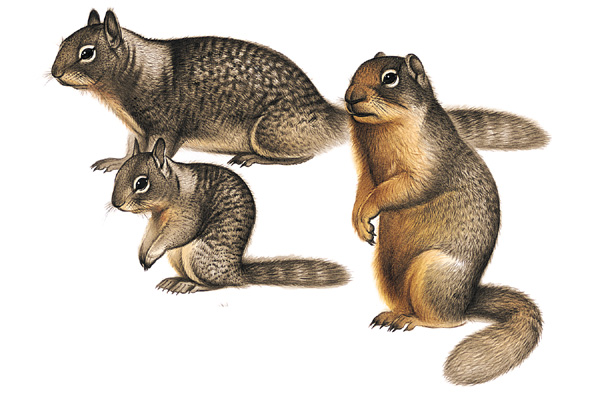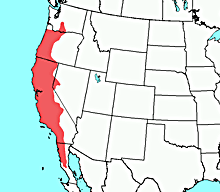 Painting by Todd Zalewski from Kays and
Wilson's Mammals of North America, © Princeton
University Press (2002)
Painting by Todd Zalewski from Kays and
Wilson's Mammals of North America, © Princeton
University Press (2002)
|
|
Description |
California ground squirrels have mottled fur, with
gray, light and dark brown, and white present in their pelage. They
typically have a darker mantle. The shoulders, neck and sides of this
species are a lighter gray. The bushy tail is a combination of the
colors that appear on the back. The underside is a lighter combination
of light brown, gray and white. California ground squirrels have a white
ring around each eye.
Length:
Range: 330 to
508 mm
Weight:
Range: 280 to
738 g
|
|
Range Map |
|
Taxonomic Hierarchy |

The California ground squirrel can be found in south central
Oregon, western Washington and most parts of California.
|
|
Kingdom: |
Animalia |
|
Phylum: |
Chordata |
|
Subphylum: |
Vertebrata |
|
Class: |
Mammalia |
|
Subclass: |
Theria |
|
Infraclass: |
Eutheria |
|
Order: |
Rodentia |
|
Suborder: |
Sciuromorpha |
|
Family: |
Sciuridae |
|
Subfamily: |
Sciurinae |
|
Genus: |
Spermophilus |
|
Species: |
Spermophilus beecheyi |
|
|
Reproduction &
Life Cycle |
Females of this species are
considered promiscuous. They will often mate
with more than one male, either through force or
selectivity, and therefore the offspring of a
single litter may have multiple paternity. Males
may also mate with several females. (Boellstorff
et al., 1994)
The mating season of
Spermophilus beecheyi occurs in early spring,
typically for a few weeks only. As with most
ground-dwelling squirrels, breeding occurs just
after the animals emerge from their winter
burrows. This is highly dependent on the area
and climate the squirrel inhabits, since the
timing of hibernation varies geographically,
with elevation, and with other ecological
factors.
Males possess abdominal
testes which drop into a temporary scrotum
during the breeding season only.
Females produce one litter
per year after of a gestation period of roughly
one month. Litters range in size from five to
eleven young. The sex ratio of young are about
1:1.
Young Spermophilus beecheyi
may open their eyes at around 5 weeks of age.
They first leave burrows at 5 to 8 weeks of age,
and are wenaed between 6 and 8 weeks. The
coloring of the young is somewhat lighter than
that of adults. Molting for young begins a few
weeks after they emerge from their burrows.
Young may begin to burrow at 8 weeks of age.
They reach sexual maturity no sooner than 1 year
old. In the first year of life, some ground
squirrels remain above ground and do not
hibernate. (Cato, 2003; Evans and Holdenried,
1943; Whitaker and Jr., 1980)
The only active parenting is
provided by the mother. Females give birth to
their pups in a burrow, and will move young into
new burrows frequently to avoid predation. Young
are helpless at birth, and their eyes do not
open until they are about 5 weeks old. Shortly
after their eyes open, the young pups leave the
burrow and begin to explore their surroundings.
(Alden et al., 1998; Boellstorff et al., 1994;
Evans and Holdenried, 1943; Whitaker and Jr.,
1980)
|
|
Conservation Status |
|
There are no special conservation
practices currently for Spermophilus beecheyi. Some
control of their numbers has been attempted, costing
several hundred thousand dollars. These are
generally targeted responses to crop damage or
disease outbreaks. (Boellstorff et al., 1994;
MacClintock, 1970) |
|
|
Habitat |
Spermophilus beecheyi has
successfully exploited many habitat types.
California ground squirrels are terrestrial, and
semifossorial, requiring habitats with some
loose soil where they can excavate an
appropriate burrow.
You may find them colonizing
fields, pastures, grasslands and in open areas
such as oak woodlands. The only habitat they do
not use is deserts. You may find them down in
valleys and up on rocky outcrops in the
mountains, to an elevation of 2,200 m. They can
be found in urban, suburban and agricultural
areas. By and large this species is widely
distributed within its range. (Evans and
Holdenried, 1943; MacClintock, 1970; Whitaker
and Jr., 1980)
|
|
Behavior |
|
California ground squirrels live
in burrow systems that can house many generations,
forming a sort of colony. Each individual has an
entrance of their own. They tend to stay within 150
yards of their burrow system and retreat, usually
only to their entrance of that burrow system. They
frequently spend time sunning themselves. Depending
on the climate, they may hibernate, or aestivate to
escape undesirable temperatures. Males are more
aggressive than females and sometimes appear
territorial.
Burrows are made under a tree,
log or rock.
The California ground squirrel is
diurnal, that means it is most
active in the daytime. |
|
Food |
|
California ground squirrels use cheek pouches while
they are foraging to collect more food than would
otherwise be possible in one sitting. They are also
known to cache or store food. They exploit a variety
of food sources, which probably contributes to their
success as a species.
The diet of these animals,
as their genus name would suggest, is primarily
seed-based. California ground squirrels consume
seeds, barley, oats, and acorns (Quercus): valley
oak, blue oak, coast oak). They also eat fruits,
like gooseberries and pears, and quail (Callipepla)
eggs. They include insects in their diets when they
are available, and have been known to eat
grasshoppers, crickets, beetles and caterpillars.
They also eat roots, bulbs, and fungi, such as
mushrooms. (Linsdale, 1946; MacClintock, 1970;
Whitaker and Jr., 1980) |
|
|
Other Names |
Sound |
- Beechey's ground squirrel (English)
- California ground squirrel (English)
- Ardillón de California (Spanish)
- California ground squirrel (Unknown)
- Californian Ground Squirrel (Unknown)
|
California ground squirrels use a variety
of sounds, tail signals and scent production as means of
communication. For example, glandular folds anterior to the
tail region are used for individual identification. When
finding a mate or mates, females may approach or males may
approach, but scent cues are important in identifying
reproductive condition. (Evans and Holdenried, 1943;
Linsdale, 1946) |
|
|
|
|
Sources used to
Construct this Page: |
- Alden, P., F. Heath, R. Keen, A. Leventer, W.
Zomlefer. 1998. National Audubon society field guide to
California. New York: Alfred A. Knopf.
- Ingles, L. 1947. Mammals of the Pacific States.
Stanford, California: Stanford University Press.
- Linsdale, J. 1946. The California ground squirrel.
Berkeley and Los Angeles: University of California
press.
- MacClintock, D. 1970. Squirrels of North America.
New York and Toronto: Van Nostrand Reinhold Company.
- Whitaker, Jr., J. 1980. National Audubon society
field guide to North American mammals. New York: Alfred
A. Knopf.
- Boellstorff, D., D. Owings, M. Penedo, M. Hersek.
1994. Reproductive behaviour and multiple paternity of
California ground squirrels. Animal Behaviour, 47(5):
1057-1064.
- Cato, F. 2003. "San Diego Natural history Museum
Field Guide: Spermophilus beecheyi" (On-line). Accessed
June 17, 2003 at http://www.sdnhm.org/fieldguide/mammals/sper-bee.html
.
- Evans, F., R. Holdenried. 1943. A population study
of the Beechey ground squirrel in Central California.
Journal of Mammalogy, 24(2): 231-260.
|
|